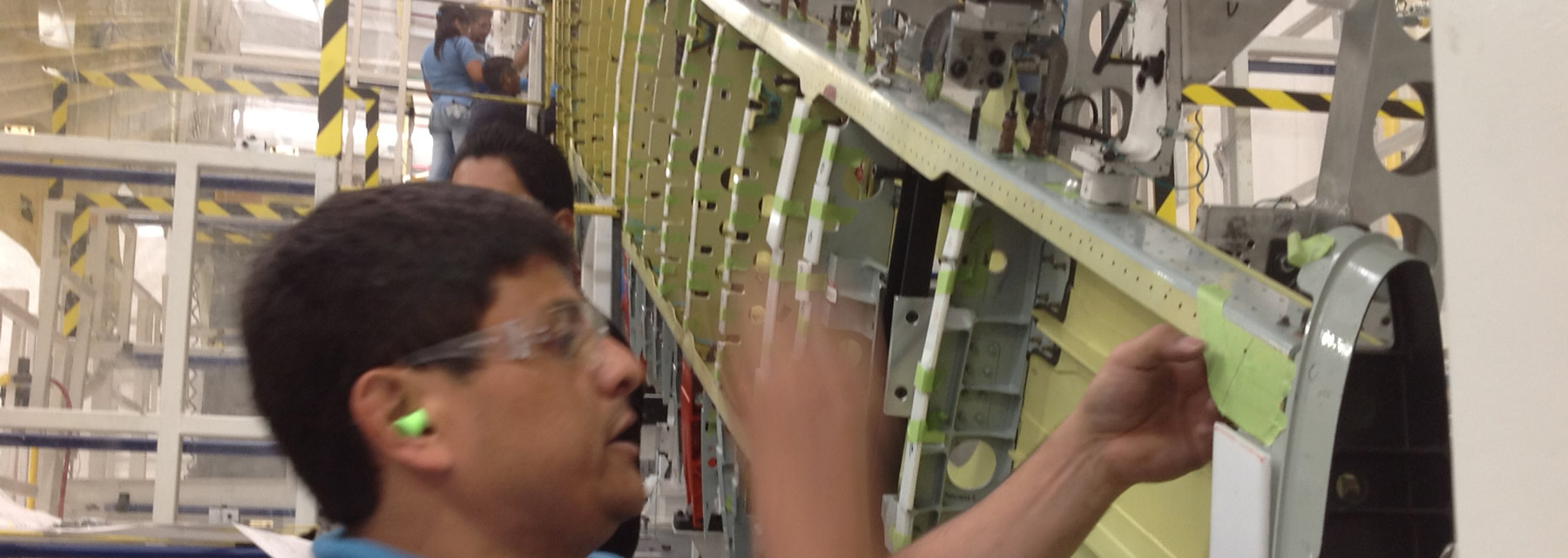The Mexican government’s US$34-million investment in UNAQ seems to have paid off. Eight years ago, there were only two aerospace companies in the region, employing about 700 people. Now, Querétaro boasts 33 aerospace companies employing more than 5,000 people, amounting to an estimated US$1.5-billion investment.
By Paul Gallant
Source: www.canadianbusiness.com
Aspiring young airplane builders experiment with various tools and grips, punching holes in grey sheets of metal as the class learns how to prepare sections of fuselage for assembly. The seemingly unglamorous task isn’t made any easier by the distraction of a half-dozen classmates playing table tennis nearby, their cheering echoing through the hangar-like space of the Universidad Aeronáutica en Querétaro (UNAQ), Mexico’s first and only aerospace university. The huge floor-to-ceiling windows look out over the Querétaro Intercontinental Airport next door and, in the distance, the grey-brown foothills of the Sierra Gorda mountains. But the real sight is out back, by the parking lot: a Canadair 7002 test jet. The Canadian-made regional jet flew its first flight in 1991 and its last in 2010, when it was flown here to be donated to the school, by executives of Bombardier Aerospace. Unpainted, with its rivets glinting in the sun, it lives on as a very expensive and very important piece of classroom equipment.
In fact, this school wouldn’t exist without Bombardier. And one might say that Bombardier Aerospace’s engineering and production facility, a sprawling five-building complex just down the dusty highway, wouldn’t exist without UNAQ. Both were founded in 2005, the school being the biggest piece of bait national and state governments used to lure Bombardier Aerospace to Mexico. In doing so, the company has helped kick-start the economy of a small Mexican state most Canadians have never heard of.
In fact, Querétaro—located far from Mexico’s tourist-packed beaches—might be the last place one would expect to find the economic future of the country. But in the 20 years since the North American Free Trade Agreement was signed, Querétaro has worked the hardest to establish itself as a high-skills manufacturing hub and, more recently, one with a specialty in aerospace. The efforts are paying off. In the last decade, the state has enjoyed an average annual GDP growth of 5.5%, the highest among Mexico’s 31 states. Although it’s one of the country’s less populous and geographically smaller regions, it consistently punches above its weight. The state is home to just 1.7% of Mexico’s 120-million population, but accounts for a growing slice of national manufacturing. Much of that success is coming from outside. In the first quarter of 2013, the state received close to US$200 million in foreign direct investment, more than twice as much as it did in the first quarter of 2012, according to the national secretariat for the economy. In a real way, Querétaro has become ground zero for a Mexican economic revolution, one that’s helping shift the country’s fortunes and providing ways for Canadian companies like Bombardier to compete with Asia and the rest of Latin America.
Among the NAFTA nations, Mexico’s advantage has always been low-cost manufacturing. “It was a really good model for Mexico, and Mexico has exploited that model up till today,” says Marcelo López Sánchez, Querétaro’s secretary of state for sustainable development. But he says the state, which has more than 50 post-secondary educational institutions, decided to use early investments as a platform for more. “Now we are developing more complex and more advanced manufacturing processes in different industries,” says López, “and we hope to compete on an international level.”
The Mexican government’s US$34-million investment in UNAQ seems to have paid off. Eight years ago, there were only two aerospace companies in the region, employing about 700 people. Now, Querétaro boasts 33 aerospace companies employing more than 5,000 people, amounting to an estimated US$1.5-billion investment. About one-third of that is from Bombardier alone. Jorge Gutiérrez de Velasco Rodríguez, UNAQ’s founding director and part of the team responsible for wooing Bombardier, says much of the curriculum was inspired by aerospace schools in Quebec and France.
“Public institutions in Mexico, unfortunately, are considered cheap and not so global. Setting up this vision, in the face of what public funding institutions expect, has been one of the biggest challenges,” says Gutiérrez. “UNAQ doesn’t look like a public institution or a university. It looks like a manufacturing facility.”
In other words, in the wild landscape of Mexico’s interior, this place is huge, spotless and state of the art. It looks like the future.
With its narrow cobblestone streets, well-preserved historic buildings, manicured public squares and trendy eateries, the capital city of Santiago de Querétaro could easily be mistaken for somewhere in southern Spain. Located about 220 kilometres north of sprawling Mexico City, Querétaro is far from both the beaches and the border. In the colonial era, the city was designated as one of the capitals of New Spain and it has retained much of its historic charm, including an 18th century aqueduct that cuts a commanding path through the city. When, by a quirk of history, France installed Maximilian I as emperor of Mexico in 1867, Maximilian’s three years of clumsy rule ended here—you can still see where he was executed.
Nowadays, the Querétaro’s main claim to fame is that it’s a remarkably pleasant place to live, with a solid middle class and relatively little visible poverty. In the last 20 years, the city’s population has doubled, to almost one million, about the size of Calgary, while the population of the state has doubled, to about 1.8 million. As Mexico’s drug wars have grown more violent, so has Querétaro’s reputation as a safe place in which to live and do business.
“Foreigners like the weather here,” laughs López, who says there are now 1,300 foreign companies in the state, 24 of them Canadian including automotive parts manufacturers Windsor Mold Group and XL Tech. “It’s the quality of life, location, cost of the land, the productivity of the people. In North America, they think the best place to be for business is close to the border. But we are one of the states with the most direct investment.”
While Querétaro is well-positioned at a key intersection of the so-called “NAFTA Highway,” the network of roads, rail and telecommunication lines that connect the U.S. to Mexico City, the state has had a long history of foreign investment. In the 1940s and ’50s, the food-and-beverage industry was the backbone of Querétaro’s economy; Kellogg’s, Nestlé and chicken producer Pilgrim’s are still here. Attempts to attract automobile manufacturing were followed by a focus on IT and biotech and finally aerospace, as leaders went after higher-valued manufacturing companies.
“This evolution of the industrial vocation of the state has changed the way of life for many people,” says UNAQ’s Gutiérrez, who is originally from neighbouring Veracruz. “With the growth, there’s a sense of having everything available—for shopping, eating, meeting people.” In fact, when Latin America’s second-largest shopping mall opened here in December, filled with designer boutiques from Burberry, Coach and Diesel, many residents were nonplussed; they’ve gotten used to fancy shopping malls.
The complaints you hear in Querétaro today are the complaints of success. Petty crime has increased, locals say, because of the influx of migrants from other states. Government has failed to improve public transit and other infrastructure quickly enough, so much that it can take a half- hour to squeeze through the bottleneck exits of some industrial parks at rush hour. Downtown traffic regularly comes to a standstill. But while the ring roads circling the city lack charm, they also display an array of shiny, new car dealerships, glitzy shopping malls, nightclubs—and a bull-fighting ring. Old and new sit comfortably side by side in Querétaro: when parents pick up their kids when school’s over, at 1:30 p.m., they’ll also pick up freshly made tortillas for comida, the afternoon meal. One joke Querétanos share on Twitter is that the welcome signs that read Suertudo, vives en Querétaro (“Lucky you live in Querétaro”) should be taken down because they attract unwanted outsiders.
Although Bombardier has been making and selling trains in Mexico for 20 years, its aerospace operations still smell new-plane fresh after eight years. The massive scale and modernity of the Querétaro campus, which has about 1,800 employees, seems a world away from Querétaro’s historic centre. And even further away from the maquiladora factories of the Mexico–U.S. border, where unskilled workers struggle to make ends meet producing consumer goods in unsavory working conditions. At Bombardier, working as an aerospace technician earns you about $25 a day to start, carries some prestige and comes with compensation packages that often include meals plus transportation to and from work.
Upward mobility is perhaps the biggest perk—and one of the keys to the success international companies are finding in Querétaro. Although designs and processes usually originate in each company’s home country—as do most of the founding management teams—the barriers between local and international staff are much more permeable than in low-skills manufacturing. UNAQ-trained grads may end up at Bombardier or at industry peers such as Safran and Eurocopter, both of which settled in Querétaro following Bombardier’s wake.
“Part of the success story is that it was not a one-time initiative to attract a company; it was a wider initiative that was seeing the future,” says Alfredo Nolasco, Bombardier’s chief country representative. “For us, we needed a qualified workforce. For students who graduate, they have almost a job secured at the end of the line, either with us or with other companies.”
When Bombardier Aerospace first arrived, the Querétaro facility was dedicated to producing electrical harnesses. It now makes them for just about every Bombardier Aerospace product. The astonishingly complex webs of cables, which connect the cockpit’s control panels and each of the plane’s mechanisms, are painstakingly strung by hand. The fussy work looks more like a craft—say, needlepoint or weaving—than high-tech manufacturing, though each of the thousands of cables has its own serial number for quality control and traceability.
When the harnessing was moved here from Montreal, Bombardier was faced with the dilemma of how to transfer the know-how from French-speaking veterans to Spanish-speaking newbies. With the help of what was to become UNAQ, the company invented its own pictogram system that operators follow regardless of the language they speak.
“The processes were—how do you say?—tropicalized,” says Pilar Abaroa, communications manager at Bombardier Aerospace México. The Querétaro facility has been influential throughout Bombardier’s global operations. Its employees figured out how to arrange the assembly line in a way that saved space, a strategy that has been adopted in other plants. The freed-up space seemed like a dare to head office to fill the vacuum—and the facility was soon given the job of producing the rear fuselage (that is, the tails), for Bombardier’s Global 5000 and 6000 business jets as well.
During my visit, I’m not allowed inside the two buildings where Bombardier is developing its Learjet 85 and Global 7000 and 8000 business jets, product lines that will use new composite-construction technology to reduce weight and improve fuel efficiency. Querétaro will manufacture both the forward and aft fuselage for the Learjet, “almost the entire body,” says Abaroa. The wings will also be assembled here before final assembly elsewhere. And Querétaro will likely be responsible for substantial components of the new Global series.
Although both product lines are in the late stages of their development (Bombardier obtained the permit for the Learjet 85’s first test flight in February), they both follow the CSeries jet in the company’s release queue. That $3.9-billion program is about a year and a half behind schedule. The company is gambling a lot on these new aircraft—and its Mexican facility.
Bombardier Aerospace’s confidence in Querétaro has proved infectious. As well as attracting suppliers, its presence here paved the way for the arrival of Bombardier Recreational Products, maker of Sea-Doos and ATVs, in 2012. Though BRP was spun off in 2003, the two companies share a chair, Laurent Beaudoin; there’s still influence there. In early 2014, BRP’s Querétaro plant had 700 employees, but by September 2015, BRP expects to have 1,100 workers here.
“You see a lot of empty space here. Why?” Thomas Wieners, director of BRP Querétaro, asks while conducting a tour of the 500,000-square-foot facility, which shares an industrial park with the likes of Samsung, Hitachi and Dow. A German native who has never lived in Canada, he has somehow picked up a French–Canadian English accent. “We designed the space for the complete Sea-Doo lineup to come here,” which will move in stages from Valcourt, Quebec.
The start-up hiccups weren’t what Weiners expected. When the facility first went into production, one of the main causes of employee dissatisfaction was the fact that the cafeteria wasn’t ready—food is a big deal in Mexico. The authoritative leadership style that had been bred in BRP’s original Mexican location, the northern border town of Ciudad Juarez, was also an irritant. The 30 or so key employees who moved to Querétaro had to adapt. North Mexican culture tends to be more aggressive, more American, while central Mexico tends to be more genteel—almost old-fashioned. Titles, tone and pleasantries matter.
“There are more sensitive expectations in Querétaro. You can’t be so assertive. When we arrived, we lost a lot of people because of those things,” says Wieners. “We had to do a lot of cultural-sensitivity training, including intra-Mexican training. Today we have a much more stable workforce.”
In addition to engine and watercraft assembly, the Querétaro facility is also home to a 100,000-square-foot Composite Fabrication Centre, a first for BRP, which has until now outsourced the fibreglass hulls for its watercraft. “I wouldn’t say it’s experimental because that would be too risky for mass production,” says Weiners, as we walk past dozens of black fibreglass hulls lining the shop floor. “But it’s not typical to bring innovation to Mexico. Normally you bring something that you completely know how to do and you want to leverage some labour content. But we believe we’ve found a strong talent pool here.”
Weiners was a key architect of the move to Querétaro from Juarez. During his seven years in Juarez, its home state Chihuahua had grown more and more dangerous. Last year, 2,783 murders were reported in Chihuahua, compared to just 112 in the state of Querétaro. (Only residents of rural Tlaxcala and touristy Baja California Sur report higher feelings of security, according to one Mexican think-tank.) When he worked in Juarez north, Weiners’ family lived in the U.S. for security reasons, requiring daily commutes across the border. BRP Mexico needed more space and the time seemed ripe to look elsewhere. Querétaro’s reputation as a safe place made it easier to attract expat talent.
In Canada, safety would seem a modest boast. Not in Mexico, where neighbouring state Michoacan has become a battleground, with armed vigilantes battling the Knights Templar drug cartel and a federal investigation into the possible corruption of more than 1,200 local police officers. It’s hard for Querétanos not to be smug, even as they worry about whether they’ll be next.
“If you look at a map, you see the drug cartels on each coast. They surround Querétaro—we’re right in the middle of it,” says Fernanda Garfias, who launched the English-language website QueretaroToday.com three years ago to serve the city’s growing English-speaking population. “There’s a theory that in Querétaro, there lives the families of all the greatest ‘narcos,’ so it’s untouchable. It’s gossip, but I hear it very often.”
And of course, just like in the rest of Mexico, low wages remain a large part in Querétaro’s international appeal. A manufacturing engineer might make less than $60 a day, compared to an estimated $35 an hour for an aerospace engineer in Quebec. Few players inside or outside of Querétaro are keen to see these wages go up yet. Although 64% of Bombardier Aerospace’s employees are unionized, López claims that international companies have a “gentleman’s agreement” to compete on perks such as food and transportation rather than wages.
That’s of little consolation to Quebec engineers who worry that Querétanos are taking their jobs. Just after my visit, Bombardier announced a workforce reduction of 1,700 positions, mostly in the U.S. and Canada.
“It’s not related,” says Nolasco. “This is part of the normal business process for any company that has to be careful about its financial position.” And while Mexican labour remains a bargain, a company trying to maintain its position as a global leader doesn’t just need labour, it needs talent. Abaroa tells me of one local employee, Juan Pablo Guerra, who started as a line operator and went on to become one of the directors of the flagship Learjet 85 project. “Today, when you see our management level, it’s a huge percentage of people who have been here since the beginning,” she says.
In the global economy, the jump from being able to manufacture high-tech products to inventing them is huge and crucial. Querétaro may be on the brink of making the leap. UNAQ’s Gutiérrez sees a day when local businesses can offer made-in-Mexico solutions. But that will take time.
“The success of Querétaro has not only been because of today’s government. There’s been a few decades where Querétaro has been doing things right,” he says. “Now it’s the opportunity for these young executives to set the pace for the coming years.”
It might take another decade for this vision to come to fruition, but Querétaro has already done the tough groundwork. The ambition of its people will do the rest of the job.
About Alder Koten
Alder Koten helps shape organizations through a combination of research, executive search, cultural & leadership assessment, and other talent advisory services. Our recruiters and executive search consultants bring to the recruiting process an in-depth understanding of the market conditions and strategic talent issues faced by clients within their particular industry. Our leadership consultants provide advisory services that are crafted to be collaborative, responsive, pragmatic, and results oriented. Focused on expanding the capabilities of the organization through talent.





